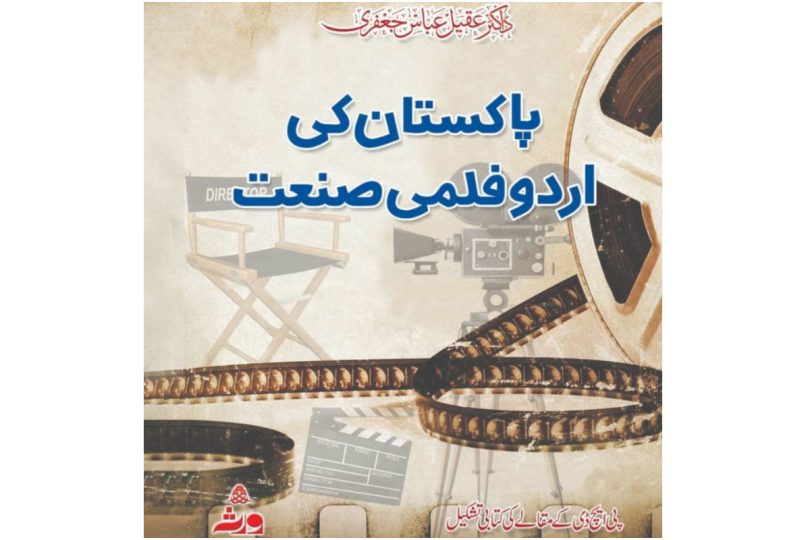At the start of the New Year, make a resolution to know Pakistani cinema, or read this book!
The earliest Pakistani film may have come out one year after the country’s independence, but the cinema industry in the region existed long before the idea of a separate Muslim state. Dr. Aqeel Abbas Jafri brings that history in the form of a book to a country where not many books have been published about the history of cinema. His work is extensive, just like his other books, and is something to be cherished, especially if you are a fan of Pakistani cinema.
Published by Virsa publications, the book’s language is Urdu which is great considering there is a dearth of quality books on cinema in the language. In fact, every book imaginable about Pakistani cinema – be it the Aijaz Gul one or the Mushtaq Gazdar one – somehow contributes to this mighty edition which begins its journey in the 1890s and ends its first edition in 2021. However, unlike Mushtaq Gazdar’s Pakistani Cinema 1947-1997, this book talks only about Urdu films, no matter where they were made, or when they were made.
By being an Urdu language book in the national language, the reach of this book would exceed expectations, even though it is priced at Rs. 12,000. But since the book is responsible for adding the prefix of Dr. on the esteemed researcher, it can serve as a guide, a reference book, and a collector’s item at the same time. Written in a chronological manner, it begins at a time when international films were only screened in India and moves into the silent era, which is preceded by films made before the Partition, after the Partition, and finally when color was added to make films, more realistic.
Laced with never-before-seen pictures, valuable information, and facts and figures that would only be known to the most ardent film buffs in the region, this book takes the readers down memory lane and gives them information they had no idea existed. It has been divided into 14 chapters which are created to give the readers an idea of how the film industry evolved in the region. While the first chapter deals with the arrival of films in the region, the second one talks about silent films, and together these two chapters cover the years from 1896 to 1934.
The third chapter handles the time between the advent of the talkies to the year Pakistan and India were created, making it one of the most interesting and sad eras of all. It was the era when the Kapoor Dynasty was established with Prithviraj Kapoor, when Baby Noor Jehan rose to the top, when a young Yusuf Khan was discovered and when one industry was divided into two, leaving half in Pakistan, hapless, and half in India, hopeful. The writer must be commended for his exquisite research till 1947 because not much has been written about this era and it wouldn’t be incorrect to say that this book contains the best research on that era.
The sixth chapter talks about the early years of Pakistani cinema, whereas the seventh and eighth talk about the 1960s, and the 1970s. If Pakistani cinema was at the top in the 1960s, it lost its battle to other options in the 1970s, and was on the verge of collapse in the 1980s, when Punjabi cinema dethroned Urdu cinema as the bigger industry. How the industry was able to survive that onslaught, how it made two comebacks, first in the 1990s and later in the 2010s to revive itself, and how it has moved forward after that, are described in the remaining chapters.
However, the 13th chapter features those films that were produced in modern-day Bangladesh (formerly East Pakistan) and you would be surprised to find out that many later year actors who dominated Urdu films were actually a product of that cinema. Without East Pakistan, there wouldn’t be a Nadeem, a Shabnam, a Rehman, or even a Robin Ghosh who played a prominent role in the formerly West Pakistan industry. The 14th chapter discusses the rise and fall of films in the country as well as suggests solutions to the many issues that seem to be hindering the film industry’s revival.
If you had no clue how big Santosh Kumar was in his heydays, that music director Khursheed Anwar directed a handful of films as well, that Suroor Barabankvi was both an accomplished lyricist and a director, and that Waheed Murad produced a couple of films before venturing into acting, then you are in need of this book. Every major library should have this book on its shelf because not only it helps the cause of reviving the Pakistan film industry, it also makes the newer readers understand what made Pakistani cinema great in the past.
And then there are the supplementary pages at the end of the book which not only feature a detailed filmography of all the films released in the country ever but also multiple lists of the silent, Punjabi, and Urdu films made in United India as well as East Pakistan. A complete list of awards presented in the country – be it the National Awards, the Nigar Awards, or the Lux Style Awards – each and every award ceremony held gets mentioned in the latter part of the book which even makes Wikipedia look obsolete and incorrect.
The author must be appreciated for collecting data from many books, some of which might not even exist today and are ‘alive’ on these pages. However, one hopes that the next edition of this book will do away with the errors and the inconsistencies that are part and parcel of such a huge compilation because that would make this book the perfect gift for a film buff, a perfect guide for the uninitiated, and a perfect collector’s item for those who know the significance of this book.







